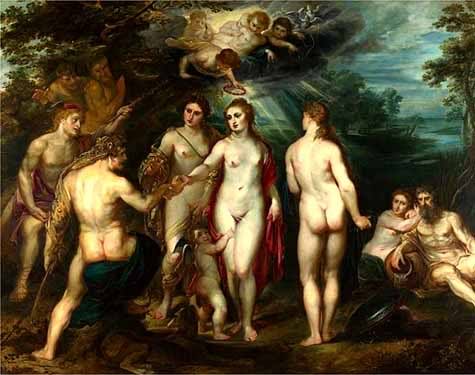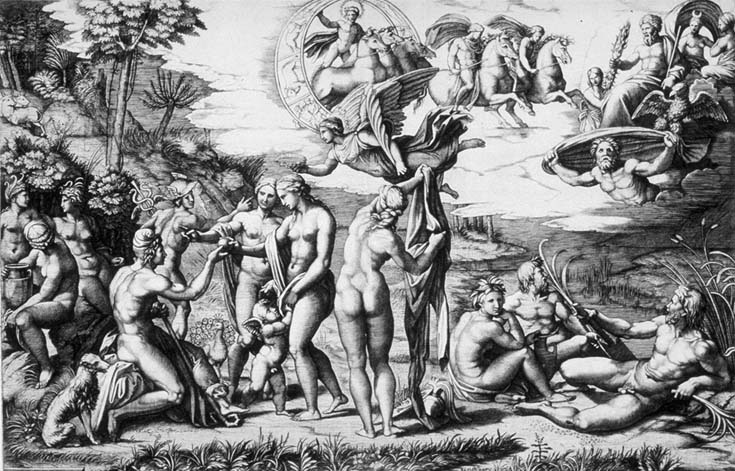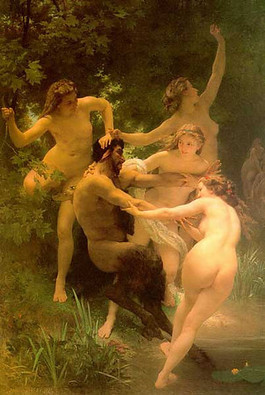He was a painter trained in the staid academic tradition but too exuberant to be constrained by it: He was influenced by the old masters, particulary Velazquez and Goya, but Manet reasoned that ones art should reflect ideas and ideals of the present rather then the past. So disagreeing with Diderot’s theory that great art only reflected the costume of the past, Manet sought instead to follow the advice of Baudelaire…to depict a contemporary realism, to be “le peintre de la vie moderne.” ( Lisa MacDonald)

The 1600 version of “The Judgement of Paris” by Peter Paul Rubens (1577-1640), which was based on Raphael’s. Rubens did at least three variations,...
Edouard Manet (1832-83) took Courbet’s realism one step further, so blurring the boundary between objectivity and subjectivity that painting has never recovered from his quiet revolution. After Impressionism, art can never return to a dependence upon a world that exists “out there” apart from the individual artist. Yet it was a quiet revolution only in that Manet was a reticent, gentlemanly artist who desired nothing better than conventional success at the Paris Salons. Temperamentally Courbet’s opposite, with his very fashion-conscious, witty, and urbane attitude, Manet was the archetypal flaneur and was well liked. To the end he could not understand why his work was so reviled by the Parisian art world and seen as an offense. Fortunately a private income enabled him to pursue his course without undue financial distress, but one cannot imagine even a starving Manet ever compromising.

"From 1862 to 1865 Manet took part in exhibitions organized by the Martinet Gallery. In 1863 Manet married Suzanne Leenhoff, a Dutch woman who had given him piano lessons and had given birth to his child before their marriage. That same year the jury of the Salon rejected his Déjeuner sur l'herbe , a work whose technique was entirely revolutionary, and so Manet instead exhibited it at the Salondes Refusés (established to exhibit the many works rejected by the official Salon).Although inspired by works of the Old Masters—Giorgione's Pastoral Concert (c. 1510) and Raphael's Judgment of Paris (c. 1517–20)—this large canvas aroused loud disapproval and began for Manet that “carnival notoriety” from which he would suffer for most of his career. His critics were offended by the presence of a naked woman in the company of two young men clothed in contemporary dress; rather than seeming a remote allegorical figure, the woman's modernity made her nudity seem vulgar and even threatening. Critics were also upset by how these figures were depicted in a harsh, impersonal light and placed in a woodland setting whose perspective is distinctly unrealistic.From 1862 to 1865 Manet took part in exhibitions organized by the Martinet Gallery. In 1863 Manet married Suzanne Leenhoff, a Dutch woman who had given him piano lessons and had given birth to his child before their marriage. That same year the jury of the Salon rejected his Déjeuner sur l'herbe , a work whose technique was entirely revolutionary, and so Manet instead exhibited it at the Salondes Refusés (established to exhibit the many works rejected by the official Salon).Although inspired by works of the Old Masters—Giorgione's Pastoral Concert (c. 1510) and Raphael's Judgment of Paris (c. 1517–20)—this large canvas aroused loud disapproval and began for Manet that “carnival notoriety” from which he would suffer for most of his career. His critics were offended by the presence of a naked woman in the company of two young men clothed in contemporary dress; rather than seeming a remote allegorical figure, the woman's modernity made her nudity seem vulgar and even threatening. Critics were also upset by how these figures were depicted in a harsh, impersonal light and placed in a woodland setting whose perspective is distinctly unrealistic."
He strove only for official recognition; he never thought of himself as making a protest , overthrowing the art of the past, or creating a new order: yet that is exactly what he did.
… The Salon mentality was both cautious and parasitic , eager to learn but more eager to conform. The public would no doubt have followed the critics’ lead to praise as quickly as they followed it to the damn, but unfortunately the most influential critics held their positions just because they were as smugly narrow in their views and tastes as were the officially established artists and the powerful directors of cultural institutions. Like the public at large, and only half understanding what Manet had done, the academicians were disturbed by his presenting a subject with an objectivity that seemed crass by the standard of sentimental idealism to which Salon painting conformed.

Raphael’s “Judgement of Paris” is in fact the engraving made from it in 1515 by Marcantonio Raimondi. Somebody lost Raphael’s copy. Not to worry, Marcantonio (c1480-c1534) was one of the best in the printmaking business, influenced by Dürer and exceedingly clever at adding in his own backdrops.
“The ambiguity of the piece resulted in varied critical response. Castagnary, the left-wing critic, wrote, “Not one detail has attained its exact and final form… I see garments without feeling the anatomical structure which supports them and explains their movements… What else do I see? The artist’s lack of conviction and sincerity” , yet he also admitted there was a “certain verve in the colors, a certain freedom of touch which are in no way commonplace” . The Goncourt brothers writing in Manette Salomon were less restrained, viewing Manet’s picture as a joke to the fine art world:
“It has become the farcical credo of skepticism, the Parisian revolt of disillusion… the great modern form, impious and carnivalesque… the Blague, this terrifying laughter, enraged, feverish, evil, almost diabolical, that comes from spoiled children, from the rotten children of the dotage of a civilization”. Despite being seen as a blague, or joke, the controversy surrounding his Déjeuner catapulted Manet to fame, making him a hero in the eyes of younger artists, such as Monet. It is not surprising, therefore, that Monet chose to make a name for himself by better painting a Déjeuner sur l’herbe.

William-Adolphe Bouguereau. "In effect, Manet increases the sexual tension by exaggerating the oppositions. And then he increases it even more by playing deadpan — making us want to burst out and demand to know what’s going on. Another, related incongruity is that Manet doesn’t depict his scene — as Bouguereau does — as happening in some dreamy far-off mythological realm where clothing might actually be optional. Manet shows it as happening right now in contemporary au courant Paris, right around the corner where I might happen upon it as I stroll through the Bois de Boulogne. Bouguereau’s painting is an attempt at perfect illusionism — I see the mythical scene with perfect clarity and I have no slightest need to linger at the painting’s surface and wonder who’s showing me what and why. Pretty as Bouguereau’s painting is — and titillating as soft-core porn — it’s as poetic as life insurance. It’s a sales vehicle: not poetry at all. In contrast to the way that Bouguereau’s attentive service fulfills my expectations, Manet trips me up at every step. I have to fight to keep my balance and understand. I have to earn my entrance into its world — to win it. I’m a participant. My act of seeing it is a joint creation: partly Manet’s and partly my own."
… As was pointed out at the time, “Le Dejeuner” could be looked at as a modern counterpart of a Renaissance painting, Giorgione’s “Concert Champetre” , in the Louvre where clothed male youths sit in a countryside with two nude females of voluptuous contours. But the Giorgione is a highly poeticized scene , perhaps an allegory with a lost key. Its air of lyrical mystery is antithetic to Manet’s odd statement of fact, which is both incontrovertible and unexplained, yet has none of the mystery
he hallucinatory quality that this combination can produce in, for instance, surrealism.
David Alan Brown:While its exact meaning has not been established, the Pitti painting seems to represent a symbolic turning point in the life of the protagonist, who literally turns away from his companion toward the older figure, interrupting the performance. Looking out at the viewer as if to underscore what is happening in the picture, the youth on the left is a Giorgionesque type like the urbane lute player in Pastoral Concert. His plumed hat further identifies him as a dandy, as in Dürer’s engraving The Promenade (ca. 1498). In Dürer’s print, the figure of Death in the background reminds the young lovers of the vanity of luxury and worldly pleasures. Though Titian’s Concert is not a vanitas or a memento mori, it similarly contrasts the self-indulgence of carefree youth with self-discipline and moral probity. What is most striking about the painting, perhaps, is the dichotomy between the two youthful figures. One is richly dressed and vapid; the other, more soberly attired and dynamic. Neither Concert excludes the possibility of an intimate relationship between the young men depicted, but only the keyboard player in the Pitti picture is clearly a portrait. His figure shows Titian abandoning Giorgionesque poetry in favor of a newly realistic portraiture better suited to his own temperament and the needs of his clients. Titian contrasts the artificiality and inertia of the Giorgionesque type, as he saw it, with the realism and expressive force of the keyboard player, who seems to embody the artist’s own vitality. In the context of the rivalry from which Titian had just emerged victorious, could the musician, while not a self-portrait, stand for the artist and his rejection of Giorgione’s manner?
A picture so openly matter- of- fact could not be licentious, but lacking any other way to explain it, critics and public fell back upon the stratagem of regarding it as, at worst, an offense against public morals, or, at best, as a laughable failure. What “Le Dejeuner” is, is a superb piece of pure painting, of art for art’s sake; an exercise in the translation of visual fact into forms and colors intended to summarize their visual essence as directly, as succinctly as possible.
In some ways “Le Dejeuner” is an unsatisfactory painting even from this point of view. It tends to break into parts; the bather in the background is ambiguously related to the others, since we cannot tell just what the distance between her and them is supposed to be. This would be alright, except that there is no reason to think that the ambiguity, which is distracting by its inconsistency, was intentional.

dalihouse-In this detail, viewers take note of a character who’s taking note of them. This is where Édouard Manet found his tableau for “Le Déjeuner sur l’herbe” in 1863. Raphael or not, polite people at the Paris Salon freaked when they saw a naked female picnicking with a couple of swank “customers”.-
There is no good way to read the relationship of one part of the landscape to another. The figures seem posed in front of a backdrop rather than to be inhabiting a wood. Essentially, this is what happened, since Manet studied the landscape and the figures separately and never unified them in a cohesive light. But as a group of individual studies, or as one beautiful surface of paint and color, “Le Dejeuner sur L”herbe” is an unequaled delight, whether it is a masterpiece or a masterpiece “manqué”.
ADDENDUM: ( from Art and Physics. L.Schlain )
Manet challenged the rules of perspective from new, relativistic coordinates. Le Dejeuner sur L’Herbe is equivalent to traveling past a picnic on a train nearing half the speed of light. Perceptual distortions include objects appearing to flatten out, the background moves closer to the foreground, shadows change from chiaroscuro to sfumato, and everything begins to look more 2 dimensional. Approaching the speed of light, space contracts. The standard representation of perspective in 3 dimensions becomes increasingly foreshortened.
Space along the train’s axis of direction contracts into an infinitely thin plane of height and depth and no length. An entire dimension is eliminated at light speed. During this period, Manet, Monet, and Cezanne deconstructed 600 years of perspective dogma to embrace a new paradigm of relative reference outside of normal human experience. In terms of cultural impact, deconstructing perspective was as revolutionary as creating it.






 COMMENTS
COMMENTS